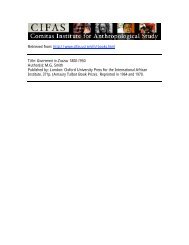Slaves, Free Men, Citizens - CIFAS
Slaves, Free Men, Citizens - CIFAS
Slaves, Free Men, Citizens - CIFAS
- No tags were found...
Create successful ePaper yourself
Turn your PDF publications into a flip-book with our unique Google optimized e-Paper software.
32 Socialization and Personality Structureissue when it is considered that almost all the Africans importedto Jamaica came from the same culture area,wwhere, as Daryll Forde observes, 'underlying the great re.gional or tribal differences . . . there is a very widespreadsubstratum of basic ideas that persists in the rituals, mythsand folk-tales of West African pe~ples'.~~THE SOCIALIZATION OQ THE CREOLE SLAVEThe Influence of the White Group. Despite the strong bondbetween mother and child, in the long run other agentswere of more importance in the slaves' upbringing thanshe was. This was due to the fact . . . that the amount oftime she could devote to her children was very limited.Usually less than two years after they were weaned, childrenwere placed under the command of a driveress inthe grass gang and later moved to other gangs which werealways separate from their parent The driver became,then, the direct authority figure for the child. But it wasnot long before the child became aware of the fact thatthe driver's authority was derived from a higher source andthat this higher source was the white group. He would havebeen told this by his mother. More important, he wouldconstantly see the authority of the whites demonstrated inthe frequent orders given by the white book-keepers oroverseers to the drivers.In the case of the children of domestic slaves-who alwaysformed a significant minority of the slave childrenthesocial superiority of the whites was demonstrated froman early age through their relationship with their whitepeer group. In our [Patterson's] chapter on the creolewhites we have seen that white children were allowed to*8 See M. I. Herskovits. The Cultore Areas of Africa', Africa,Vol. 3 (1930), where nine cultural areas are demarcated.a* Daryll Fordc, The Culture Map of West Africa', in Simonand Phoebe Ottenberg, eds., Cultures and Societies of Ajrica(New York: Random Home, 1960), p. 123.Orlando Patterson 33mix freely with their black peere. M'Mahon has left in anaccount of what happened in these early peer group auonations:The inbred arrogance of a white child brought upamong black children is painfully pressed upon the observationof a person unaccustomed to such a land of tyrannyas a slave colony always is. At even two years ofage the black child cowers and shrinks before the whitechild, who at all times slaps and beats it at pleasure andtakes away its toys without the smallest manifestation ofopposition on the part of the piccaninni. I have frequentlyseen a white child crying, when the little dave,so utterly a slave from his bii, would say to the cryingchild,-'Massa, knock me, don't cry; you my maasa; meyou nega9.MIn later life, the slave discriminated between the differentorders of whites. Generally, if the owner was absentee, theattorney (who paid periodic visits to the estate) was seenas their owner and true master. Should the absentee ownervisit the island, his authority was immediately recognizedand all the apparent adoration due to him was given. Notefor example, the tumultuous welcome given M. 0. Lewiswhen he visited his estate for the first time. Of course, ifthe owner actually lived on the estate, the matter was madethat much simpler.41On one level, Long's assertion that they eye and respecttheir master as a father and are extremely vain in reflectingon the comexion between thems* may have been generallytrue. Thus their own estimation vis4-vis the slaves ofother estates was largely a reflection of their master's atatuain the community. The slaves also appeared to emulatetheir masters and copied 'not only their dress but imitate4OB. M'Mahon, Jamaica Ptantership (London, 18391, p.293.41 It should be remembered that while the majority of ownerelived on the island, because of the unequal distribution ofdavea among whitea, the majority of slaves were owned bymasters who were absentee.aLong, op. cit., Vol. 2, p. 410.





